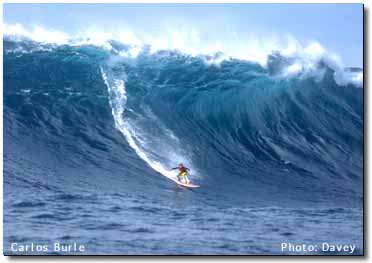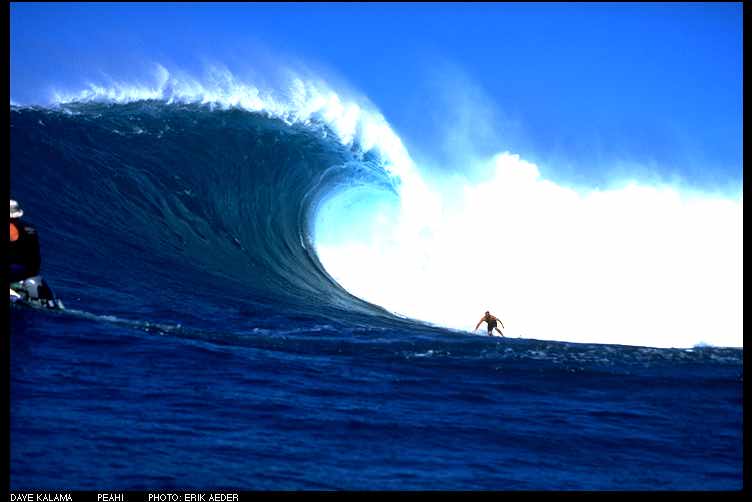

Waves generate much sound and fury, impressing us greatly, so we can probably be forgiven for exaggerating their size. I once spent a miserable day tossed around in a small cod boat off the southern coast of Iceland by waves I was certain were at least twelve feet high. They came at us like they were attacking, rising out of the choppy chaos of smaller waves until they crested above the height of the cabin roof and seemed about to come down like giant fists. It was humbling and a little disappointing to learn later from the weather service that the waves had been mere six-footers. I've taken some comfort since watching anglers on Lake Michigan motor into harbors for protection from waves measuring barely three feet from trough to crest.
Even in the open ocean the immense waves of popular imagination are rarely encountered. At least three-quarters of all sea waves have a height less than 12 feet, and only very powerful storms produce mountainous seas of more than 30 feet. Nonetheless, some parts of the oceans have earned notoriety from producing larger-than- average waves, some of them very large indeed. Many of the biggest waves that reach the shores of Europe and eastern North America originate in the middle of the North Atlantic, especially in the stormy regions south of Iceland and Greenland. The long rollers that frequently strike the southwest corner of England can begin as far south as the Cape of Good Hope, South Africa -- some 6,000 miles away. In the Pacific, swells washing on the shores of California and even Alaska have been traced to the Antarctic Ocean. The winds south of Cape Horn, at the southern tip of South America, follow the "Screaming Sixties" all the way around the world without interruption by continents. This endless fetch produces long, powerful waves known as "graybeards" or "Cape Horn Rollers" by mariners who claim they have seen them measure a mile from crest to crest and reach heights of 200 feet.
Such figures were once discounted as the result of fancy and fear by oceanographers convinced that no wave could surpass 60 feet in height without collapsing. But this "60-foot rule" has been challenged recently by computer models that seem to prove that powerful storms are capable of creating waves as high as 219 feet.
The big waves of computer models, of course, are an exercise in theory divorced from practice. In nature, waves are not nearly as predictable and orderly as they are in laboratories, computers, and mathematical equations. While features such as velocity, period, and length are easy to measure in controlled circumstances, in the open ocean they can be hopelessly confused. Swells the size of small hills come at you from several directions at once, each rising and descending unpredictably, the slopes hacked by wind waves and covered with a perplexity of tiny capillary waves. One moment a breaking curler rushes down the slope of a large swell, then a trough fills with the crest of a wave coming from the side or falls away into yet a deeper trough. The random and disorderly nature of waves in the oceans almost guarantees that they will occasionally produce waves of a higher order. Such "rogue," "freak," or "episodic" waves are known as Extreme Storm Waves (or ESW) when they develop within a storm, and often rise in groups of three that have earned the quasi-mythical designation "Three Sisters Waves." Most reports of ESWs note that they look like "walls of water," that they're accompanied by steep-sided and unusually deep troughs (deep enough to occasionally swallow a ship), and that they spill forward and break simultaneously and with equal energy the entire lengths of their crests. An enormous freak wave with those characteristics struck the Queen Mary amidships south of Newfoundland while ferrying U.S. soldiers home at the end of World War II, rolling her to within a degree or two of capsizing.
Rogue waves can occur on relatively calm seas with no storms for hundreds of miles. Trains of swells traveling in the same direction but at different speeds will pass through one another; when their crests, troughs, and lengths happen to coincide they reinforce each other, combining their energies to form unusually large waves that tower mountainously for a few minutes then subside. Such giants can suddenly reach several times the height of most of the waves around them, forming mid-ocean breakers that are probably responsible for at least some mysterious disappearances of ships. When such anomalous waves occur near shore, roaring down without warning on piers and rocky ledges, they sometimes sweep people to their deaths.

When waves meet opposition in an oncoming current the wavelength is shortened and the wave is forced to become steeper and as much as two to four times higher. Examples can be seen on a relatively small scale at the mouths of rivers or estuaries, where the outflowing current creates high choppy waves that can be dangerous for small craft. When a current exceeding about four miles per hour is spread over a large area and involves massive amounts of water the danger is magnified. Regions notorious for such hazardous juxtaposition of waves and current include the Agulhas Current off the east coast of South Africa, the Kuroshio Current southeast of Japan, and the Straits of Florida and elsewhere along the Gulf Stream, where 30-foot waves blown up by nor'easters sometimes reach 40 to 60 feet in height.
Reports of rogue waves a hundred or more feet in height are no doubt often exaggerated, but careful measurements by coolheaded observers have left little doubt that waves of that size sometimes occur. One fairly reliable way sailors have measured such waves is to climb the rigging until they reach the point, while the ship is in the bottom of a trough, at which the crest of the wave lines up with the horizon. The height climbed then equals the height of the wave. This technique, or variations on it, have been used to measure some waves of terrifying dimensions.
One of the largest waves ever measured was reported by Navy Lieutenant Commander R. P. Whitemarsh in a famous paper titled "Great Sea Waves," published in the U.S. Naval Institute Proceedings in August 1934. Whitemarsh encountered a storm on February 7, 1933, while crossing the Pacific in the navy tanker the U.S.S. Ramapo. During this storm, west winds had a fetch across thousands of miles of unobstructed ocean and had already blown at gale force for days. With the wind at 60 to 66 knots (69 to 76 miles per hour) directly from the stern and the waves consistent, without cross seas, Whitemarsh and his crew were able to estimate (based on the 478-foot length of the ship) that the length of the waves was 1,000 to 1,500 feet. Using a stopwatch they timed wave periods up to 14.8 seconds. Crew members standing on the ship's bridge could measure the height of a wave by lining up its crest with the horizon and a point on the ship's mast (making the line of sight approximately horizontal) while the stern of the ship was at the bottom of a trough. By triangulating from the line of sight to the bottom of the ship's stern (or the trough of the wave) they were able to determine the height of each wave. The largest they measured was 112 feet.
Other notable waves have been measured against stationary objects, especially lighthouses. In the winter of 1861, for example, the Bishop Lighthouse in the Isles of Scilly was struck by a wave high enough to smash a fog bell hanging 100 feet above the ground (eyewitnesses insisted the crest of the wave came down on the bell), breaking a metal support bracket four inches thick and tossing the bell to the rocks below where it smashed to pieces. Waves have occasionally passed over the top of the 75-foot-high lighthouse on Minots Ledge, Massachusetts, and have flung rocks through the glass of Oregon's Tillamook Rock Lighthouse, 133 feet above the water.
How do you measure wave height?
There are lots of different methods of judging wave size.
A lot depends on what is customary in your part of the world. Scientifically we use meters, peak to trough, but at the beach that is meaningless in that everyone else there is using different 'scale', and each area has it's own scale. [almost, but not quite entirely unlike feet].
It is usual to adhere to local custom, however if conversing with those not familiar with it, it is best to call surf height in multiples of body height, i.e.: waist, chest, shoulder, head high, overhead; x times overhead etc. Most of us will be within 12" of 6' tall. If you wish to add the local height in "feet" then great.
Some people measure the "backs" of the waves, which they often define as half the height measured from the front. In fact the backs of waves are as high as the fronts, though at breaking they are not as steep. This and perspective tends to lead to the height estimated from the "back" being about half that from the front.

 Back to Surf Home
Back to Surf Home